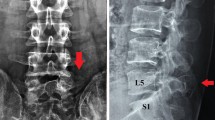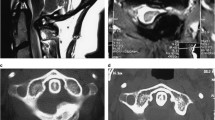Abstract
We report a case of an osteochondroma in a 47-year-old woman presenting with a 2-month history of thoracic back pain that radiated down her left arm. Based on imaging features, the osteochondroma was initially thought to represent a calcified meningioma. The unusual features of the case include the location of the tumor, patient age, the erosion of the vertebra, and the confusing neuroradiological features. We review reported cases in which a solitary costal osteochondroma impinges on the neural foramina or central spinal canal and we discuss reasons for the misdiagnosis in our case.
Similar content being viewed by others
Avoid common mistakes on your manuscript.
Introduction
Osteochondromas are common benign bone neoplasms. These tumors most commonly occur in the distal femoral, proximal tibial, or proximal humeral metaphysis of adolescents and young adults, seldom affecting the ribs, pelvis, or scapula [1]. Merely 1.5% of all osteochondromas are costal, and even more uncommon are those that occupy a neural foramen, causing spinal nerve root or cord compression [2]. There are to our knowledge only 5 reported cases of a solitary osteochondroma of a rib with extension into the spinal canal, causing spinal cord compression. Tumors that commonly extend through the neural foramen into the spinal canal include metastatic cancers, meningiomas, nerve sheath tumors, and other primary bone tumors.
We report an unusual case of an osteochondroma in a middle-aged woman that was initially thought, based on imaging findings, to be a calcified meningioma. Pathological examination of the excised tumor tissue showed that the mass was most consistent with an osteochondroma. The unusual features of the case include the location of the tumor, the patient’s age, the erosion of the vertebra, and the confusing neuroradiological features. This case is presented in the context of a literature review of solitary costal osteochondromas impinging on the neural foramina or central spinal canal.
Case report
A 47-year-old woman presented at our outpatient spine clinic with a 2-month history of thoracic back pain that radiated down her left arm. She described the pain as “achy,” stated that it was worse when she was standing, and she rated the pain at its worst as 8 out of 10. She also had radiating pain mostly in her left chest just above her breast. She reported swelling of her left wrist and a sense of “jumpiness” in her legs particularly at night. She denied bowel or bladder dysfunction, paralysis, joint stiffness, or any numbness. She stated that muscle relaxants did not help her pain. There was no family history of neurological dysfunction or bony tumors.
Physical examination revealed hyperreflexia in the lower extremities, sensory loss at a level around T5, and bilateral positive Babinski responses. She had full strength in her bilateral upper and lower extremities. Clinically, the pain was thought to arise from a variety of possible causes, including thoracic radiculopathy, fibromyalgia, rheumatological disease, and spondylosis.
Routine laboratory tests were within normal limits. Multiplanar multisequence magnetic resonance imaging (MRI) of the thoracic and lumbar spine revealed a 1.4-cm (in its greatest diameter) extradural mass on the left at the T6 level, deviating the spinal cord to the right and filling the left T6—T7 neural foramen (Fig. 1). The mass caused concave remodeling of the posterior cortex of the T6 vertebral body, and showed a small amount of peripheral enhancement. Computed tomography (CT) of the thoracic spine showed the mass filling the left T6–T7 neural foramen, eroding the posterior portion of the vertebral body, the undersurface of the pedicle, and the inferior portion of the articular pillar (Fig. 2). There were irregular calcifications within the mass. The presence of a bony stalk leading from the rib to the irregularly calcified mass was missed (Fig. 2c). A CT-guided needle biopsy was performed, and contained only normal bone. This was interpreted as a nondiagnostic biopsy. Based on the irregular calcifications and the deviation of the thecal sac, the preoperative clinical and radiological diagnosis was a calcified tumor, probably a meningioma.
MRI obtained for thoracic radicular pain. a Axial T2-weighted image shows a high-signal intensity mass (arrows) filling the left lateral recess. Its medial border is irregular. b Sagittal T1-weighted image through the mass (arrows) shows that the mass has irregular borders. It is of high-signal intensity centrally, and has a low-signal rim around it. c Sagittal short tau inversion recovery image through the mass (black arrows) shows that the mass is primarily of low-signal intensity, but has areas of high-signal intensity too. Appearance is consistent with a partially calcified mass. Note scalloping of the posterior margin of the vertebral body (white arrow)
CT scans obtained for further evaluation of the mass and for biopsy guidance. a Sagittal reformatted bone window shows that the mass (black arrows) seen on MRI contains mature ossification. The contour of the mass is somewhat irregular, and its periphery contains small, round calcifications, which in retrospect reflect the partially calcified cartilage cap. The mass is eroding the vertebral body, pedicle, and pars interarticularis. The reactive sclerosis of the eroded bone is indicative of a slowly growing mass. b Axial bone window shows that the mass (white arrows) contains irregular areas of calcification that constitute the calcified cartilage cap of the osteochondroma. There is medullary continuity of the mass with the rib, which was not recognized prospectively. The pedicle and transverse process are eroded
The patient underwent surgical resection of the tumor. The excised tissues consisted of multiple pieces of bone, in aggregate 2.0 × 1.5 × 1.5 cm, Histological sections (Fig. 3) of the decalcified tissue revealed fragments of lamellar bone with signs of remodeling (empty osteocyte lacunae and others with osteocytes, reorganized osteons, and osteoblasts rimming some bone edges) and cartilage with large chondrocytes in irregular clusters of lacunar spaces embedded in an extensive mature matrix. The cartilage and bone had irregular interfaces. As the lesion was resected piecemeal it was felt that it was not possible to make a definitive diagnosis of osteochondroma, but the pathological appearance was strongly suggestive of that diagnosis.
Histopathology of the excised mass. The mass was resected in multiple pieces (see text). a Some of the pieces consisted of hyaline cartilage and others were bone (upper right). Hematoxylin and eosin (H&E), original magnification ×40. b The cartilage pieces were abnormal, with multiple nests of several large chondrocytes clustered together. H&E, original magnification, ×200. c The bone pieces were all mature lamellar bone, but there was evidence for remodeling, with empty osteocyte lacunae and small osteocytes in other such spaces. H&E, original magnification ×400
Her postoperative recovery was uneventful and she was free of pain. A CT scan obtained 6 months after surgery showed subtotal resection of left sixth rib head. There was no recurrence at follow-up 1 year after surgery.
Discussion
Solitary osteochondromas are benign bony neoplasms thought to arise from a focus of epiphyseal cartilage that has separated from the growth plate and continues to proliferate into the metaphysis [3]. The aberrant cartilage remains in a subperiosteal location [3]. As the cartilage continues to grow away from the growth plate, normal bone forms behind the advancing cartilage. This process forms an exostosis of normal bone. The osteochondroma is always continuous with the medullary cavity; in childhood, it is capped with cartilage on its distal margin, where the growth takes place. The cartilage cap tends to regress with skeletal maturity. The cartilage cap may calcify in an irregular pattern. In our case, the irregularly calcified cartilage cap was mistaken for a calcified meningioma.
A solitary osteochondroma of the rib causing spinal cord or neural foraminal compression was to the best of our knowledge first reported in 1976, and we were able to discover only 5 reported cases of this phenomenon. Of those 5 patients, 3 patients were male, 2 patients were female, and only 1 patient was above the age of 21 (Table 1). Three of the cases reported vertebral erosion; however, none to the extent of this case. Osteochondromas typically present in adolescent and young adults (peaking in the 2nd decade of life), making it extremely unlikely to have a newly symptomatic osteochondroma in a middle-aged patient.
In our case, a preoperative misdiagnosis was made. This happened because the attention at imaging was focused on the irregularly calcified cartilage cap, and the continuity of the mass with the adjacent rib was overlooked. Medullary continuity of the exophytic mass with the underlying bone is a key feature of osteochondroma, and helps to distinguish from other surface bone lesions.
Because of the spinal cord compression, surgical management was needed. As a general rule, all osteochondromas causing cord compression should be surgically resected, given the risk of spinal cord injury [8]. The risk of malignant degeneration is less of a consideration than risk of neurological compromise, as malignant degeneration of a solitary osteochondroma is estimated to be <1% [9].
Conclusion
Solitary osteochondromas invading a neural foramen and causing spinal compression are extremely rare, with only 5 known documented cases in the literature. To our knowledge, not only is this the first report of a costal osteochondroma occurring in a middle-aged woman, but also the first report of an irregularly calcified cartilage cap mimicking a calcified meningioma.
References
Folpe A, Inwards C. Bone and soft tissue pathology. Philadelphia, PA: Saunders/Elsevier; 2010.
Chazono M, Masui F, Kawaguchi Y, Hazama H, Ueda J, Saito S, et al. Dumbbell-shaped osteochondroma of the fifth rib causing spinal cord compression. J Orthop Sci. 2009;14(3):259–61.
Milgram J. The origins of osteochondromas and enchondromas. Clin Orthop Relat Res. 1983;174:264–84.
Twersky J, Kassner E, Tenner M, Camera A. Vertebral and coastal osteochondromas causing spinal cord compression. Am J Roentgenol. 1975;124(1):124–8.
Natarajan M, Balakrishnan D, Srinivasan V. Solitary osteochondroma causing spinal cord compression. Int Surg. 1976;61:494–5.
Kane P, Coulthard A, Raghavan R, Jenkins A. Osteochondroma of the rib: an unusual cause of paraparesis. Surg Neurol. 1994;41(5):414–7.
Rao A, Abraham R, Rajshekhar V. Osteochondroma of rib with neural foraminal extension and cord compression. Neurol India. 2007;55(4):428.
Shim J, Park C, Shin S, Jeong H, Hwang J. Solitary osteochondroma of the twelfth rib with intraspinal extension and cord compression in a middle-aged patient. BMC Musculoskelet Disord. 2012;13(1):57.
Karasick D, Schweitzer ME, Eschelman DJ. Symptomatic osteochondromas: imaging features. Am J Roentgenol. 1997;168(6):1507–12.
Author information
Authors and Affiliations
Corresponding author
Ethics declarations
Conflicts of interest
None.
Rights and permissions
About this article
Cite this article
Sampath, A.J., Miller, D.C., Mesfin, F.B. et al. Osteochondroma mimicking meningioma: case report and literature update. Skeletal Radiol 46, 825–829 (2017). https://doi.org/10.1007/s00256-017-2608-7
Received:
Revised:
Accepted:
Published:
Issue Date:
DOI: https://doi.org/10.1007/s00256-017-2608-7







